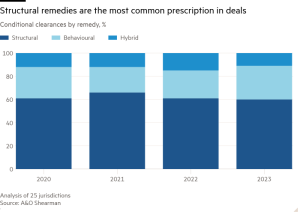Japan’s unfortunate political limbo
Unlock the Editor’s Digest for free
Roula Khalaf, Editor of the FT, selects her favourite stories in this weekly newsletter.
The last time Japanese voters turned against the Liberal Democratic party was in 2009. Disgusted by a stream of political scandals, and turned off by a carousel of shortlived prime ministers, they threw the LDP out. The result was widely welcomed at the time as a coming of age for Japanese democracy, seeming to herald the arrival of a competitive two-party system. That turned out to be a false dawn. The opposition government that took over was a fiasco. It presided over the Fukushima nuclear disaster and left in 2012 with its credibility in tatters.
Following a new stream of political scandals, and a carousel of shortlived prime ministers, the LDP has now been defeated again in a snap election last weekend, albeit less decisively. For Japan to enjoy some electoral competition is a healthy thing. But the danger is that it will end up with a weak and incoherent government at a time when its economic, demographic and security challenges have never been greater.
The new parliament is unlikely to run for a full term. In the coming period of political turmoil, therefore, the onus is on the LDP to show it is capable of reform and on the opposition Constitutional Democratic party to show it is serious, so Japanese voters have a worthy choice next time around.
Before the election, called by prime minister Shigeru Ishiba last month only days after he unexpectedly won the leadership of his party, the LDP held 247 seats, against the 233 needed for a majority in Japan’s lower house. With the 32 seats held by its allies in Komeito, that was sufficient for a stable administration.
Following the election, the LDP and Komeito have 215 seats between them, and even with a scattering of independents that will not be enough to form an administration. The most attractive additional partner is the centre-right Democratic Party for the People, with 28 seats, but that will produce a weak coalition at best.
There is pressure on Ishiba to take responsibility for the LDP’s poor result and resign. An immediate departure, however, would delay coalition negotiations, show contempt for all the voters who have just cast their ballots and leave Japan without a prime minister at a moment when the US, Japan’s indispensable security partner, is about to select a new president. Ishiba would be better advised to stay on for now, assemble a coalition, pass a budget and try to make some progress on reform of political funding.
The opposition in the CDP are elated but they should not celebrate too hard. With 148 seats, they were still well behind the LDP. More seriously, this was not a vote for them. It did not indicate some populist turn or upheaval in Japanese society; rather, it was a vote of exhaustion with the LDP. If the CDP wants to win next time, it needs to show it is serious.
Among the policies the CDP championed at the recent election was a proposal to lower the Bank of Japan’s inflation target from 2 per cent to “greater than zero”, which would abandon more than a decade of effort to drag Japan out of deflation. It has ambitious carbon reduction goals but wants to shut down nuclear power completely. It says it wants to “further strengthen a healthy US-Japan alliance” but is lukewarm about almost every step taken to improve Japan’s security. This is a recipe to repeat the failures of the 2009-2012 period.
That is a pity, as both Japan and the LDP would benefit from a competent, socially liberal opposition party getting a turn in government. That was not the outcome this year. The actions both parties take now will decide whether, next time around, Japan can vote for change.
#Japans #unfortunate #political #limbo




